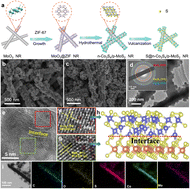One-dimensional confined p–n junction Co3S4/MoS2 interface nanorods significantly enhance polysulfide redox kinetics for Li–S batteries†
Abstract
Exploring MoS2-based sulfur hosts with high performance is an effective strategy for promoting the extensive application of Li–S batteries. Hence, one-dimensional (1D) Co3S4/MoS2 nanorods (n-Co3S4/p-MoS2 NR) have been prepared via a self-sacrificial template method to solve these issues by forming a p–n junction interface. Characterization reveals that the 1D MoO3 templates effectively confine the growth and stacking of MoS2 nanosheets and the p–n junction Co3S4/MoS2 interface increases electron transfer ability in the battery reaction. Furthermore, DFT calculations suggest that the interfaces can reduce the energy barriers of the rate-determining step (RDS) in lithium polysulfide (LiPS) transformation. Consequently, the S@n-Co3S4/p-MoS2 NR cathode exhibits high specific capacity, remarkable rate capability, and outstanding cycling stability with capacity fading of 0.01% per cycle over 1000 cycles. Additionally, under ultrahigh sulfur loading (14.8 mg cm−2) and lean electrolyte conditions (E/S = 5 μL g−1), a brilliant areal capacity of 11.3 mA h cm−2 is retained after 100 cycles at 0.1C. This work provides a new way to prepare complicated MoS2-based nanocomposites for long-life LSBs.



 Please wait while we load your content...
Please wait while we load your content...